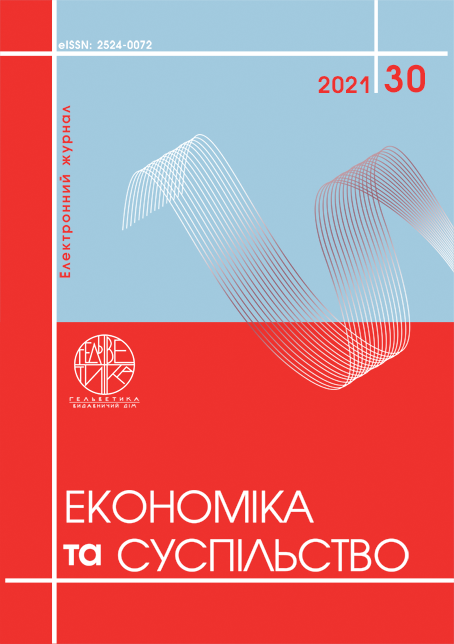DIAGNOSIS OF FINANCIAL SUSTAINABILITY OF ENTERPRISES IN THE CONDITIONS OF STRENGTHENING GLOBAL COMPETITION
Abstract
The article investigates various theoretical approaches to defining the concept of financial stability. Based on the analysis of economic literature sources, the essential features of financial stability are identified. The necessity of using the analysis of financial stability of the enterprise is substantiated. The most optimal approaches to the analysis and assessment of financial stability of the enterprise are revealed. The main groups of factors influencing the financial stability of the enterprise are clarified. The types of financial stability and importance in the activities of enterprises were considered. It is determined that financial stability implies solvency in the long run, its assessment should be aimed at determining the stock of financial stability. This gives an idea of sales, which ensures the stable operation of the enterprise. Today, one of the main problems of enterprises is the lack of a holistic strategy aimed at ensuring the sustainability of financial and economic activities of the enterprise and sustainable development in the future. The financial problems faced by enterprises are largely identical in their economic essence, and therefore their solution is possible with the help of universal tools and standard measures that form the mechanism for managing the financial stability of the enterprise. The analysis of financial stability on the example of a specific enterprise of PJSC "Concern Khlibprom" for 2018-2020. The ways to improve the situation to ensure maximum development of the enterprise and achieve greater profits are indicated. The importance of planning and control to ensure financial stability is revealed. Recommendations for stabilizing the financial activities of enterprises in conditions of fierce competition have been developed. Using the results obtained in the article by managers and specialists of enterprises will allow increasing the level of validity of organizational and economic measures that are aimed at reducing the risk of insolvency of enterprises and avoiding their bankruptcy. In addition, the obtained results can be applied for the development of strategies of crisis financial management at the enterprises.
References
Офіційний сайт Державної служби статистики України. URL: http://www.ukrstat.gov.ua (дата звернення: 15.09.2021).
Заюкова М.С. Теорія фінансової стійкості підприємства : монографія. Вінниця : Вид-во «Універсум», 2009. 155 с.
Москалець К.М. Визначення поняття та функцій категорії «фінансова стійкість» як критерію ефективності фінансової діяльності підприємства. 2010. С. 81–88.
Старостенко Г.Г., Мірко Н.В. Фінансовий аналіз : навч. посіб. Київ : Центр навчальної літератури, 2006. 224 с.
Тютюнник Ю.М. Фінансовий аналіз : навч. посіб. Київ : Знання, 2012. 815 с.
Ясіновська І.Ф. Сучасні підходи до оцінки фінансової стійкості підприємств. Європейські перспективи. 2016. Вип. 2. С. 169–175.
Олійник Л.В. Стратегічні напрями забезпечення фінансової стабільності підприємства. Фінанси, облік, банки. 2017. № 1 (22). С. 118–124.
Чегринець К.В. Фінансова стійкість підприємства: економічна сутність та методи оцінки. Управління розвитком. 2012. № 10. С. 51–54.
Приймак С.В., Волкова О.А. Інформаційне забезпечення фінансової діагностики підприємств. Принципи формування зовнішньої політики держави: економічні та інституціональні аспекти : матеріали міжнар. наук.-практ. конф., м. Ужгород, 14-15 травня 2021р. Ужгород : ДВНЗ «УжНУ», 2021. С. 92–94.
Приймак С.В., Воляник Г.М. Вдосконалення інформаційного забезпечення діагностики фінансово-господарської діяльності суб’єктів господарювання. Науковий вісник Львівського державного університету внутрішніх справ. Львів : ЛьвДУВС, 2015. Випуск 2. С. 275–287.
Ofitsiinyi sait Derzhavnoi sluzhby statystyky Ukrainy. Available at: http://www.ukrstat.gov.ua. (accessed 15 September 2021).
Zaiukova M.S. (2009) Teoriia finansovoi stiikosti pidpryiemstva [Theory of financial stability of the enterprise]. monohrafiya [a monograph]. Vinnytsia: Universum, 155 p. (in Ukrainian).
Moskalets K.M. (2010) Vyznachennia poniattia ta funktsii katehorii «finansova stiikist» yak kryteriiu efektyvnosti finansovoi diialnosti pidpryiemstva. [Definition of the concept and functions of the category "financial stability" as a criterion for the effectiveness of financial activities of the enterprise]. «Materialy mizhnarodnoi naukovo-praktychnoi konferentsii Vi "Nauka i osvita bez kordoniv – 2010», pp. 81–88.
Starostenko H.H., Mirko N.V. (2006) Finansovyi analiz [Financial analysis]. Kyiv: Tsentr navchalnoi literatury, 224 p. (in Ukrainian)
Tiutiunnyk Yu.M. (2012) Finansovyi analiz [Financial analysis]. Kyiv: Znannia, 815 p. (in Ukrainian)
Yasinovska I.F. (2016) Suchasni pidkhody do otsinky finansovoi stiikosti pidpryiemstv [Modern approaches to assessing the financial stability of enterprises]. Yevropeiski perspektyvy, no. 2, pp. 169–175.
Oliinyk L.V. (2017) Stratehichni napriamy zabezpechennia finansovoi stabilnosti pidpryiemstva [Strategic directions of ensuring the financial stability of the enterprise]. Finansy, oblik, banky, no. 1 (22), pp. 118–124.
Chehrynets K.V. (2012) Finansova stiikist pidpryiemstva: ekonomichna sutnist ta metody otsinky [Financial stability of the enterprise: economic essence and evaluation methods]. Upravlinnia rozvytkom, no. 10, pp. 51–54.
Pryimak S.V., Volkova O.A. (2021) Informatsiine zabezpechennia finansovoi diahnostyky pidpryiemstv [Information support of financial diagnostics of enterprises]. Pryntsypy formuvannia zovnishnoi polityky derzhavy: ekonomichni ta instytutsionalni aspekty: materialy mizhnarodnoi naukovo-praktychnoi konferentsii. Uzhhorod: DVNZ «UzhNU», pp. 92–94.
Pryimak S.V., Volianyk H.M. (2015) Vdoskonalennia informatsiinoho zabezpechennia diahnostyky finansovo-hospodarskoi diialnosti subiektiv hospodariuvannia [Improving the information support for the diagnosis of financial and economic activities of economic entities]. Naukovyi visnyk Lvivskoho derzhavnoho universytetu vnutrishnikh sprav. Lviv: LvDUVS, vol. 2, pp. 275–287.


